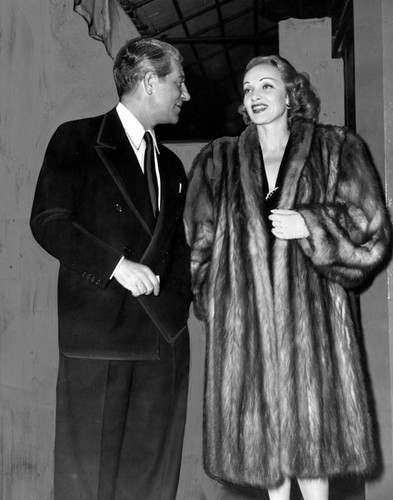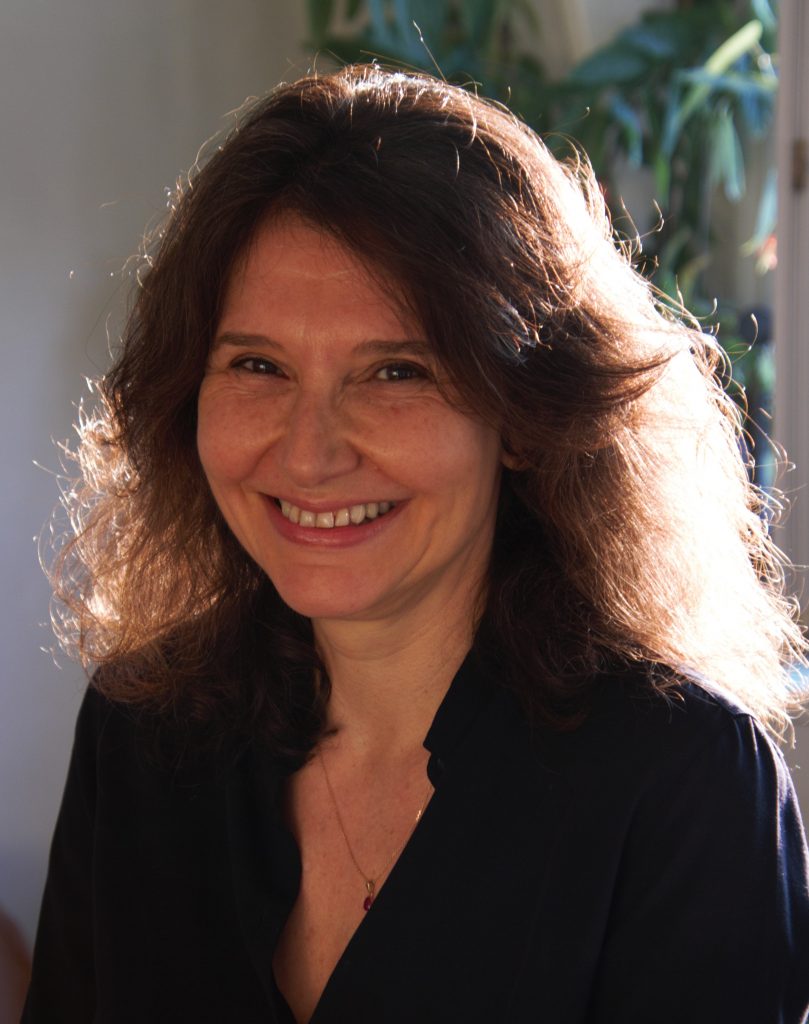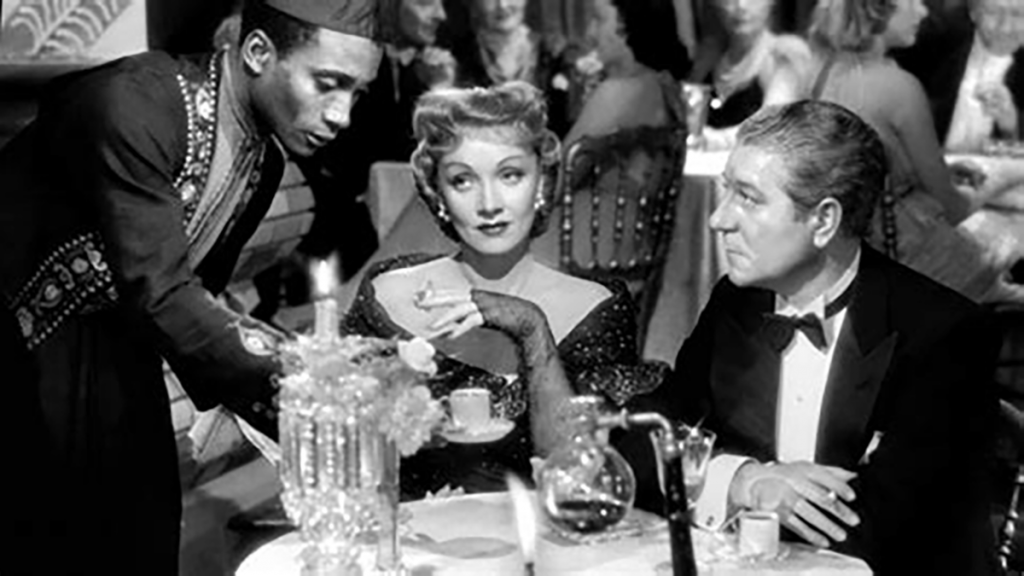Exclusive Interview with Laurence Braunberger: Martin Roumagnac Restoration Project
Rarely-seen French film noir classic Martin Roumagnac (American title The Room Upstairs), a 1946 film by Georges Lacombe, is now available in a 4K restoration. Starring Marlene Dietrich opposite her real-life lover Jean Gabin, Martin Roumagnac is the only movie these two icons ever made together.

Lacombe’s tragic postwar romance is a tale of class anxiety and classic Romantic fatalism, run through with a typically French frankness (for the times…) about sex and gender. Gabin is the titular character, an unpretentious and proudly working class building contractor, who falls in love with Dietrich’s ravishing shopgirl Blanche, quite unaware that she comes trailing a notorious history and attracts the determined ardor of every man she meets. Among her current lovers is a local politician who plans on marrying Blanche once his terminally ill wife dies, but Gabin’s sensible lug doesn’t care, though it’s clear that the ever-opportunistic Blanche will choose wealth over love. Until she doesn’t.
Both Lacombe’s film and Dietrich’s performance have a sphinx-like attitude toward this femme fatale, and that still-gestating film noir stereotype is subtly deepened. Blanche is not judged. The men that buzz around her are not villainized, either – they’re just following their toxic hearts, in a culture where women have few options. All the while, as the melodrama heats up, Gabin and Dietrich radiate pure matinee charisma.
Martin Roumagnac was digitized and restored in 4K with the support of the CNC (Centre national du cinéma). Run time 115 minutes, black and white, in French with English subtitles. An Icarus Films release available for rent or purchase.
Classic Couple interviewed Laurence Braunberger of Les Films du Jeudi about the gorgeously restored film Martin Rougmagnac.
Q1: What attracted you to Martin Rougmagnac as a restoration project?

My father, the producer Pierre Braunberger (1905-1990) bought this film, along with other films from the same production company, just before he died. It took us a long time to solve the legal problems. Concerning the material, the film existed only in SD / low definition or in a very damaged 35 mm print. I dreamed of restoring the film since I took over the company to be able to show it in theaters and in the best quality possible. You can imagine for French people: a film with Marlene Dietrich!
Q2: Seventy-seven years on, what does Martin Rougmagnac offer first-time viewers of the film?
What seems obvious in this re-release in a restored version of Martin Rougmagnac is the possibility of seeing on screen the only collaboration of the mythical and yet ephemeral couple of Jean Gabin and Marlene Dietrich. The leading man of French cinema, landed from America with greying hair and a softened face, signs his return in the French cinematographic landscape after an exile of five years. Marlene Dietrich (“my Prussian” as Gabin called her) played her one and only role in French in Martin Roumagnac, and her first important role in Europe since Josef Von Sternberg’s cult The Blue Angel in 1930.
Dietrich and Gabin, who met in New York during the war, both refused to play in Les Portes de la Nuit (Gates of the Night) by the duo Carné / Prévert, although it was written for them. Replaced by Yves Montand and Nathalie Nattier, Gabin preferred to shoot Martin Roumagnac, an adaptation of a novel by Pierre-André Wolff, the rights to which he had bought before the war. This passion in real life is thus recorded on the screen in a dark, fatalistic film where the love of Martin Roumagnac — a mason by profession and notable of a medium-sized town in eastern France — for Blanche Ferrand, a bird seller of Australian origin with dubious designs, will lead him to his downfall.
The film was nonetheless a significant public success (2.5 million tickets sold in France alone). This was a turning point in Gabin’s career and acting, as he had just passed his forties and was no longer the young leading man of the realist-poetic cinema of the 1930s. Any spectator familiar with his roles in Carné, Duvivier, or Grémillon will be delighted to discover an aging Gabin, more controlled in a nuanced performance where gestures and voice filled with tenderness and gentleness rub shoulders with flashes of violence all in restraint. The viewer can also appreciate some supporting roles that stand out despite the overwhelming presence of the couple Gabin-Dietrich: Margo Lion playing Jeanne, Martin Roumagnac‘s moving sister who does everything to save her brother from the fall that threatens him; the sadly little-known actor Jean d’Yd, playing Blanche Ferrand’s uncle, a Michel Simon’s look put at the service of an ambiguous character, disturbing at times, who evolves in the shadow of his niece. Finally, this is one of the first important roles of Daniel Gélin, a future leading man of French cinema, a favorite actor of Jacques Becker and who has notably played for Hitchcock. And now only Marlene remains.

Q3: How important is this film in the career of Marlene Dietrich? Why must Dietrich fans discover Martin Rougmagnac?
Martin Rougmagnac is the return of Dietrich to Europe after a second part of her career in the United States. If the first half of the 1930s and her collaboration with Sternberg was fruitful, Marlene Dietrich quickly became the “poison of the box office” as the press started calling her. Hollywood roles became scarcer and her participation in the war effort put her film career on the back burner. When the conflict ended, she was aging and could no longer find a role in the United States so Dietrich joined her lover Gabin in Paris. Fiercely committed against Nazism since the 1930s, she refused to play the role of a collaborator’s daughter that Marcel Carné offered her in Les Portes de la Nuit (The Gates of the Night). She preferred to join her lover to play in the adaptation of Martin Rougmagnac.
In France while the film becomes a success in theaters, in the United States its distribution was accompanied by an aura of scandal. On the one hand, the relationship between Gabin and Dietrich while the actor was still married shocked puritanical America. His divorce did not take place until 1943, but the relationship between the two actors, which began in 1941, was no secret. On the other hand, Blanche Ferrand, the character played by Marlene Dietrich, is a woman with extremely liberal morals. The immorality of the character shocked the censors to the point that the film was shortened by about thirty minutes when it was released in American theaters. Marlene Dietrich nevertheless glows in her role, where all the photogeneity of the actress shines. We know from Daniel Gélin, supporting role in the film, that the actress herself adjusted the lights when she was not satisfied with the lighting of Roger Hubert (although he was an extremely qualified director of photography, among others on the two Abel Gance’s Napoleon and Les Enfants du Paradis).
We find in Martin Rougmagnac something of the Marlene of Sternberg’s films. A close-up of Marlene Dietrich’s legs is the first thing we see of her, going down the stairs of her store while smoking. These legs that made the popularity of the actress (in Kismet, filmed in early 1944, her legs painted in gold created a stir in the American press) will be seen many times in the film. It is they who will seduce Martin Roumagnac / Jean Gabin during the boxing match where he meets her. They are also the ones who will fascinate Daniel Gélin, pushing him to murder. Another element, anecdotal and yet so characteristic of Marlene Dietrich is all the art she deploys while smoking a cigarette. The so banal and insignificant act of smoking is magnified by the actress’s acting. This stately bearing mixed with a very laid-back attitude reminds us of her characters in Morocco or in Shanghai Express.
After her breakup with Jean Gabin, Marlene Dietrich never shot a movie in France again and returned to the United States to shoot with Billy Wilder in A Foreign Affair. The only film played in French by the actress who perfectly masters the language (for the sake of the plot, her German accent is justified by her Australian origins), Martin Rougmagnac is more than just a linguistic curiosity in her career, and the film is indispensable for any Dietrich fan who has not yet seen it or who would like to see it again in this superb restoration.


Q4: How does this film stand out in the film noir genre? And in the history of realism in French cinema?
If we associate Martin Rougmagnac with film noir, it is worth recalling that the genre partly derives from the poetic realism movement of the interwar period. The fatalism and pessimism of this movement, combined with a quasi-expressionist photography, had a direct influence on American filmmakers. Obviously, Lacombe’s film is a direct descendant of poetic realism, although it cannot be strictly classified as such. Although it features Jean Gabin, an iconic actor of the genre, and the darkness of films by Carné or Grémillon, the film, clearly aware of its origins, subverts or plays with certain essential motifs of poetic realism.
Martin Rougmagnac can be roughly summarized as a story about the downfall and decadence of a notable in a rural town in the Nancy region who had the misfortune of falling for a woman with questionable motivations. The screenplay, adapted from a novel by Pierre-René Wolf published in 1935, appears at first glance to belong to a long line of films that take up the myth of the femme fatale, including Murnau’s Sunrise, Renoir’s La Chienne, and the unforgettable Blue Angel immortalized by Marlene Dietrich. However, while the lineage is prestigious, it would be inappropriate to consider this film as just another clichéd dramatic film.
Martin Roumagnac holds some surprises that add depth and bring new interest to the film. The screenplay goes beyond the simple opposition between the seductive vamp embodied by Marlene Dietrich and the honest worker embodied by Jean Gabin who gets drawn into a downward spiral. In a realistic approach, the love story is set against a background of class struggle, between rural and urban areas, which inevitably separates the two lovers with irreconcilable aspirations. Blanche Ferrand has lived her whole life in Paris, between Montparnasse and Montmartre, and is bored with her new existence as a bird seller in a small rural town. On the contrary, Martin Rougmagnac, a mason and notable in his community, swears by manual labor and exudes the carefree attitude of someone who is content with what he has. Like an echo of the post-war, reformed Gabin, the actor has left behind the typical role of a marginal from a working-class background in Le quai des brumes (Port of Shadows) or Le jour se lève (Daybreak) and abandoned the anxious urban setting typical of poetic realism for a life in the open air. Gabin thus trades the resigned impetuosity of those characters pursued by fate for a naïve optimism that will not prevent him from being caught up in an inevitable death.
“Fate…well, fate doesn’t exist”
Martin Roumagnac
The character of Blanche Ferrand also deviates from the genre’s canon. As a stereotype of the femme fatale acting out of greed, what ultimately separates the two lovers is not Blanche’s ambition as their incompatible personalities, which strangely echo the lives of Jean Gabin and Marlene Dietrich, whose relationship ended abruptly after filming. For it is the naturalness of Martin Rougmagnac that seduces Blanche Ferrand. Manipulative, she has no interest in playing games with Martin Rougmagnac and even goes so far as to break off a relationship with a consul who promised her a comfortable life. The lack of redemption of the character played by Marlene Dietrich, who is ultimately murdered by her lover, mistakenly convinced that he has been duped, constitutes major traits of this fate that constantly pursues the two characters.

It was not a very difficult restoration, because we had all the elements even if they were very damaged and we were able to restore the film from the original nitrate negatives. Thanks to Laboratoire Hiventy for the image and Le Diapason for the sound for this superb restoration!
The unexpected joys are to be able to understand better and better the film and the relationship of this mythical couple during the viewings. Aside from watching films, playing games like 카지노 can also be a great way to spend leisure time.
Classic Couple Recommends
The 4K restoration of Martin Roumagnac is a must-see for Dietrich fans. Icarus Films release available for rent or purchase.
Watch the trailer.
